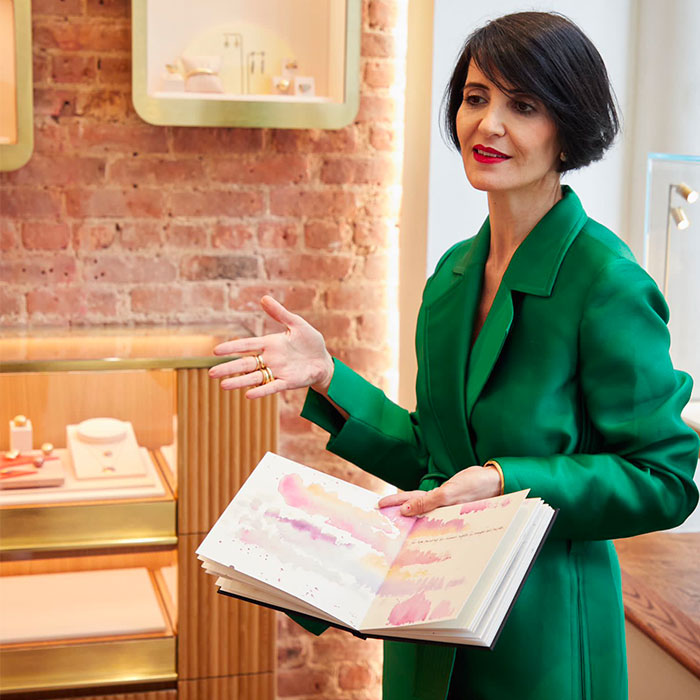Business
15 January 2024
Share
The Trunk Show Trend
The trunk show is to the designer what the concert is to the musician: a way to meet the public and generate sales. Long practiced in the US and Asia, the concept is now taking off in Europe.
By Sandrine Merle.
Miami, NYC, Dallas, Seattle, Hong Kong, Paris, Beirut… Designers criss-cross the globe to boost jewelry sales at trunk shows organized at their retailers’ premises. In Paris, Stéphanie Roger, founder of WhiteBird multi-brand boutiques, explains: “the designer comes to present new or unique pieces to customers in person, in addition to the selection I offer.” For the designer, who generally take their pieces back with them, it’s also about telling their story, their inspiration, and how they make their pieces. “Who better to do this than Sylvie Corbelin and Vishal Kothari themselves?” explains business strategist Lionel Geneste who organizes their American “marathons”.
The trunk show of the 2000s
The trunk show concept is not new. It comes from the United States, where it was already in vogue in the early 2000s. “I used to tour boutiques twice a year, starting in San Francisco and ending in Palm Beach by way of New York,” recalls designer Taher Chemirik. “I had the sensation of being wildly desired, and was invited by the biggest boutiques like Barney’s and Janet Brown on Long Island. I was received like a prince, picked up by limousine and treated to sumptuous dinners for customers, often accompanied by their husbands. I was even the subject of a billboard campaign in the city!”
The trunk show today
The concept has been much more democratized: “post COVID, trunk shows have multiplied to the point where, in some American boutiques, there can be three a week”, explains Lionel Geneste. All the agents agree that they are the logical continuation of the consignment approach, reconciling boutiques that no longer take the risk of buying jewelry (with rare exceptions) with designers who have had enough and no longer want to/can’t stockpile inventory. “The customer, too, is delighted, because it’s a social event that flatters them, giving them the impression that they’re unique when they meets the designer or dine with them, in small groups”, explains Valery Demure, consultant in jewelry and gallery owner.
Risk of overdose?
Sylvie Corbelin at Just One Eye or at Cayen. Marie Lichtenberg at Marissa. Sia Taylor, Karen Liberman, Brooke Gregson, Hum at WhiteBird à Paris. Fernando Jorge or Elie Top at Sylvie Saliba à Beyrouth. Kloto at Objet d’Emotion or A’Maree’s in Newport. They confirm, the trunk show has become a must, and some make great use of it. But like all excellent recipes, it can’t be reproduced endlessly for fear of becoming stale. Boutiques, saturated with demand, tend to become completely passive, relying entirely on the designer to promote and finance the event. “Now, even in the heart of NYC, an insufficiently prepared trunk show no longer draws the crowds,” warns Lebanese designer Sélim Mouzannar. Over-solicited, customers have grown weary… In the United States, it’s clear that they don’t want to consume as much as they used to. And the younger generation doesn’t care: they often prefer to buy based on photos,” says Geneste, who is now betting on fewer commercial events.
The future of trunk show
Will too many trunk shows kill the trunk show? Is the exceptional in danger of becoming banal? To avoid devaluing the concept and running out of steam, a few precautions are in order: “I don’t do more than a dozen trunk shows a year in my three boutiques,” warns Stéphanie Roger. I make sure that I don’t always appeal to the same customers, by presenting them with designers that match their tastes. And I don’t do trunk shows with all the designers represented at WhiteBird. In any case, “the trunk show remains a must”, says Marie Lichtenberg. So bankable designers have to be both full of energy and free as a bird … to be able to tour the planet several times a year!
Related article :
Consignment, a hurdle to creativity – Valery Demure
Banner image : Kloto trunk show at Objet d’Émotion, Londres


















